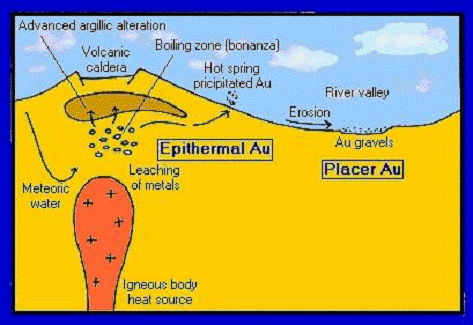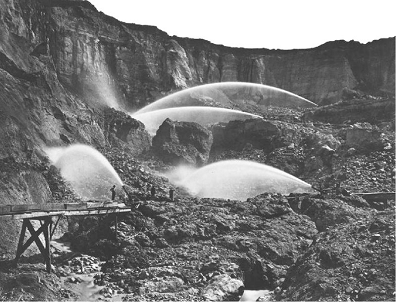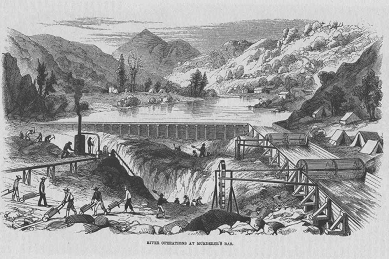Geology and Natural Heritage of the Long Valley Caldera
Gold Mining and its Environmental Impacts
Monika Fryska
Abstract
This paper examines the economical, agricultural, and environmental effects of the California Gold Rush of 1848 and the following years. After gold ore is formed through hydrothermal deposition, it is near enough to the Earth's surface, that it can be mined for its monetary and aesthetic value. Common mining procedures of the California Gold Rush included placer mining, hydraulic mining, and lode mining. The promise of gold brought thousands of people to California , and with them came the potential for economic growth and agricultural expansion. However the massive migration of people to the area and the destructive forces caused by over mining also resulted in dire consequences for the environment.
INTRODUCTION
Throughout history, gold has been mined and refined to meet the needs of people globally. Its chemical and physical properties have caused it to be one of the most sought after minerals on the planet. It has been the focus of many epic historical conflicts, and the cause of much controversy. Because of its rarity and distinct qualities, gold has a very high monetary value and has often been used as currency. The rarity of gold is due to the extraordinary geological processes required to produce it and the difficulty in extracting and refining gold ore. These processes are often time consuming, destructive to the landscape, and harmful to the natural habitat surrounding the mining area. As a result mining gold ore is expensive and controversial in many parts of the world. An excellent example of the tremendous efforts and struggles associate with mining is the California Gold Rush in the Sierra Nevada .
PROPERTIES OF GOLD
Gold is most revered and treasured for it stunning shine and beautiful luster, however, gold also exhibits several other unique characteristics. It is most famous for it's characteristic bright yellow color, which has made it extremely popular for use as jewelry. Gold is a transition element with the atomic symbol Au and atomic number 79 (Encarta Encyclopedia - Gold website). It is “the most malleable and ductile metal” and can therefore be easily shaped and reformed (Wikipedia- Gold website). Gold can be easily melted and reshaped an unlimited number of times. Its durability and resilience make it a very useful commodity. In addition, gold is also an excellent conductor of heat and electricity and is a very inactive element. Gold will not reactive with air, heat, water, or most other solvents, which explains why “its radiance is forever” (Bernstein, 2000). Its chemical structure makes it virtually completely resistive to most corrosive agents. No matter what it is exposed to, gold will always shine as brightly as it did when it was first formed.
USES OF GOLD
Gold is most famous for its use in jewelry. This is mostly due to its brilliant yellow luster and its never fading beauty. As a result it has been used to adorn buildings, artwork, and furniture from all eras (California Geological Survey website). Gold is also well known for its use as currency and its monetary value in trading. Because gold is virtually indestructible and very rare, it has a very high monetary value. Gold is used as the reference metal for most national currencies. Many countries have gold reserves, and the total world gold reserves is about 50,000 metric tons (Butterman 2005).
GEOLOGICAL BACKGROUND
Gold is formed deep within the Earth's surface by a series of geological processes. Gold deposits in the Sierra Nevada region are formed by hydrothermal systems such as the one seen in the figure below.
Figure 1 : Hydrothermal gold deposition system. Figure reproduced from
e-goldprospecting.comMinuscule amounts of gold and other minerals can be found in almost all areas, however before gold lode deposits can form, a hydrothermal system is required. A magma source deep beneath the surface heats meteoric water to superheated temperatures (Hill 2006). These magma sources are often found in subduction zones where one plate is riding over another. This superheated water is capable of dissolving a higher concentration of minerals than regular water due to the immense pressure it is under. The superheated water, along with the dissolved minerals, begins to rise toward the surface through cracks in the earth's surface known as veins (Hill 1999). These cracks are often the result of faulting or fractures in the Earth's surface and can be found in areas of seismic activity. As the superheated water continues to rise, it cools and the amount of pressure it is under decreases, which causes the dissolved minerals to begin precipitating (California Geological Survey website). This results in highly concentrated regions of gold in veins within mountainsides.
The easiest gold to access, and which is most commonly mined, is gold formed by placer deposits. Placer deposits are the result of weathering or erosion of lode deposits (California Geological Survey website). Small fragments of gold are broken off of the mother lode, and carried away by wind, water, or gravity. Most commonly streams and rivers will pick up the gold particles and then deposit them further downstream. The size of these fragments varies and can range from dust to nugget-sized particles, however they are usually relatively small due to the fact that gold is dense and difficult to transport. The placer gold deposits are most commonly found along riverbeds, lake bottoms, or near alluvial fans (Silva 1986).
HISTORY OF THE CALIFORNIA GOLD RUSH
The California Gold Rush officially began when James Marshall discovered gold at Sutter's Mill in central California , but gold had been found on several occasions prior to Marshall 's discovery (Hill 1999). However, Marshall 's find was the first to be publicly advertised across the nation. News of the discovery was broadcast in all parts of America and prompted thousands of people to traveled to California in hope of striking it rich (Wikipedia: California Gold Rush website). People set up small camps along rivers and streams and began the massive quest for gold. These towns were mostly temporary, since people tended to move where the gold was found (Hill 1999). Often entire towns were abandoned in a matter of days leaving behind the famed “ghost towns.” As more gold was found, the methods of excavation evolved. The new mining procedures were often more invasive and harmful to the environment.
As California 's population continued to rise, so did its economic prosperity. The California Gold Rush has been credited with helping California make the transition from Mexican province to official statehood (Wikipedia- California Gold Rush website). The Gold Rush also brought many new technologies and industries to California . The western railway systems and agricultural productions were both greatly increased as a result of the thousands of people who moved to California in search of gold (Hill 1999). The mining industry also created thousands of jobs for both skilled and unskilled workers, which resulted in a major boost in the Californian economy.
MINING PROCESSES
PLACER MINING
Placer mining was one the first methods used to extract gold from the lakes and streams surrounding the Sierra Nevada Mountains . This process uses the density of gold and the force of gravity to separate gold particles from other sedimentary deposits (Silva 1986). In the United States the majority of gold mined is from placer deposits (Butterman 2005). Although placer mining can be done with simple tools such as gold pans, more sophisticated techniques have been developed. Since gold panning was a time and labor-intensive processes, early prospectors developed sluices to divert water from their natural paths. With the water diverted and the riverbed exposed, they were able to easily and effectively excavate the area in order to search for gold (Wikipedia: California Gold Rush website). Another common method was to build a long tom, which was an aqueduct like pathway that diverted water from streams. The long toms allowed prospectors to quickly and efficiently scour through large volumes of water (Butterman 2005).
Figure 2 : Prospectors search for using a long tom. Figure reproduced from Silva (1986).
HYDRAULIC MINING
After the rate of gold discoveries began to subside, prospectors started to search deeper for gold. Much of the gold that had been carried by streams and rivers that are now dry, was embedded within mountainsides behind large quantities of bedrock and gravel. In order to get to this gold, the overlying rock and sand had to be removed. Miners used high-powered streams of water to blast away these overlying rocks in order to free the gold trapped within them (Butterman 2005).
Although hydraulic mining was simple in principle, it required many new tools and techniques in order to be an effective form of gold ore extraction. The most important aspect of producing hydraulic power was the massive amount of water needed. Huge projects were undertaken to provide miners with the water they needed to perform hydrological mining (Hill 1999). The efforts required to reroute rivers and drain lakes brought thousands of jobs for people in California . Massive systems of levees and reservoirs were constructed in order to bring water to the bases of mountains where hydraulic mining was preformed (Hill 1999).
Another important invention that was made around the same time as the development of hydraulic mining was the production of nozzles specially designed to produce high-power jets of streams. In order to break through the thick deposits of gravel and sand, extremely high-pressured water was used as seen in the figure below.
Figure 3 : Hydraulic mining in California . Figure reproduced from Gibbons (2006).
These cannon-like nozzles were easy to handle and tremendously effective at demolishing entire mountainsides (Hill 2006). They allowed miners to search deeper for placer deposits than the simple methods of gold pan mining.
In order to capture and isolate the gold, mercury or arsenic amalgamation was used. After the mountainside was blasted with the hoses, the drainage would be captured and sifted through sluices. Often mercury was added to the sluices to help capture the small particles of gold present (Butterman 2005). The mercury would react with gold allowing for easier extraction. The mercury and arsenic were used excessively and waste was often not disposed of properly.
LODE MINING
After it was discovered that the gold in rivers did not originate there, miners began searching farther for the “mother lode” of gold deposits. Lode deposits are the direct result of hydrothermal activity below the Earth's surface (Hill 2006). They often require more digging and excavation then placer and hydraulic mines. The lode gold was buried deep within mountains in a series of quartz veins (California Geological Survey- Gold website). The quartz veins in which the gold was incrusted were very difficult to drill through, thus complicating the process of lode gold extraction. Often explosives and extensive underground drilling were required in order to reach the lodes (Butterman 2005).
Lode deposits that are just under the surface can usually be reached by surface mining. This open-pit mining technique requires the removal of just the outermost layer of bedrock above the gold deposit. The gold can than be refined through a series of chemical processes (Hill 1999). The more invasive underground lode mining requires complex series of tunnels and vents to be dug through mountainsides (Hill 1999). This form of mining is very expensive and labor-intensive. There are also many hazards related to underground mining. Since the lode deposits can be found very deep underground, high temperatures and tunnel collapses were especially dangerous for early Californian prospectors (Wikipedia- California Gold Rush website).
EFFECTS OF THE GOLD RUSH
Due to the invasive procedures used to mine gold, the environment suffered a major blow as a result of the California Gold Rush. The massive amounts of hydraulic mining preformed in the Sierra Nevada region, caused a huge disruption to the beautiful mountainous landscape. Entire hills were flattened and mountainsides were gouged out by the immense force of the high-powered hoses, many of which could displace as much as 4,000 cubic yards of Earth per day (Kiester 1999).
Figure 4 : Rerouting of river waters. Figure reproduced from Wikipedia- California Gold Rush website.
Another problem with hydraulic mining was the immense volume of water used. In order to provide the miners with the volume of water they required, mining companies rerouted entire streams using series of aqueducts and reservoirs (Butterman 2005). After the water was used to blast the mining area, it was allowed to flow freely wherever it chose, resulting in flooding and mudslides (Kiester 1999). A mix of trees, shrubbery, rocks, and water known as “slickens” was the result of unregulated hydraulic mining (Kiester 1999). These slickens would flow over towns and farms causing massive destruction of everything in their paths. They not only affected the natural habitats of wildlife, but also acres of crop fields. This depletion of agricultural resources resulted in an outrage of the local farmers. Many cities filed lawsuits against the mining companies to prevent the destruction of their crops (Hill 1999). As a result the Anti-Debris Association was formed in order to regulate the water flows of the hydraulic mining sites (Hill 1999).
Along with the excessive water flow, chemical waste was also a destructive factor of gold mining. In order to free gold from the quartz veins, corrosive agents such as mercury and arsenic were often used by the miners (Hill 1999). The mercury and arsenic were not carefully handled and as a result were often allowed to run into water sources and soil. This type of contamination has proven to be harmful to wildlife and vegetation, and has resulted in some of the worst toxic waste sites in America (Butterman 2005). At the time of the California Gold Rush, there was very little formal law or government regulation concerning mining. The mining community had very little regard for the environment, and the dangerous affects of mercury contamination were not well known (Hill 1999). During the California Gold Rush, the water and soil contamination caused by leeching mercury and arsenic, led to the death of waterfowl and other wildlife in the area.
In many areas of the Sierra Nevada , the aesthetic beauty of the mountains was compromised by the gold miners. Since thousands of people were migrating to the Sierra Nevada , new towns and communities had to be developed. This resulted in the clearing of hundreds of acres of land and logging thousands of trees. Along with clearing areas for people to live, forests also had to be cleared to make room for agriculture (Hill 1999). Although this resulted in a major boost for the economy, it also displaced wildlife from their natural habitats.
The damaging mining techniques used by early prospectors also resulted in the destruction of entire landscapes. Hydraulic mining could displace as much as 4,000 cubic yards of Earth per day, thereby flattening many hills and gouging out entire mountainsides (Kiester 1999). The mining companies held very little regard for the environment and focused entirely on profits. Explosives were used to produce open-pit mines for lode mining during much of the California Gold Rush (Hill 1999). Also explosives were often used merely for exploratory purposes. Once the miners were finished with a particular mine, it was simply abandoned with no effort to cover their tracks or restore the site to its natural state (Hill 1999).
CONCLUSION
Overall, the California Gold Rush was an economically and agriculturally glorious period in American history. However with the expansion of the population and the economic prosperity came devastation for the environment. Lack of organization, regulation, and responsibility led to a very environmentally unfriendly era in our history. Blinded by the glory of gold, prospectors destroyed the natural treasures of the Sierra Nevada . Due to the difficulty of extracting lode gold, which is formed beneath the Earth's surface in quartz veins, dangerous mining practices were often used. Both the placer and lode miners needed a way to extract the gold they discovered. Chemical amalgamation was preformed with very little monitoring of mercury and arsenic. The leeching of chemicals into the ground combined with the destruction of natural landscapes resulted in tragic consequences for the environment.
REFERENCES:
Bernstein, Peter L. The Power of Gold. John Wilet and Sons Inc: New York , 2000.
Butterman, W.C. and Earle B. Amey III. “Mineral Commodity Profiles- Gold.” United States Geological Survey. 2005.
“California Geological Survey-Gold.” State of California Department of Conservation. http://www.conservation.ca.gov/cgs/geologic_resources/gold/Pages/Index.aspx
Epithemeral Gold Deposits. http://www.e-goldprospecting.com/html/epithermal_gold_deposits.html
Gibbons, Helen. San Francisco Bay Floor Explored in Public Lecture. United States Geological Survey- Sound Waves Newsletter. January 2006. http://soundwaves.usgs.gov/2006/01/outreach.html
Hill, Mary . Geology of the Sierra Nevada . University of California Press: Berkeley, 2006.
Hill, Mary . Gold: The California Story. University of California Press: Berkley , 1999.
Kiester Jr., Edwin. “Turning Water to Gold.” Smithsonian . Volume 30, Issue 5, Page 18, August 1999.
MSN Encarta Online Encyclopedia: Gold http://encarta.msn.com/encyclopedia_761570498/Gold.html
Silva, Michael. “Placer Gold Recovery Methods.” California Department of Conservation Division of Mines and Geology. 1986.
Wikipedia.org: California Gold Rush http://en.wikipedia.org/wiki/California_Gold_Rush
Wikipedia.org: Gold http://en.wikipedia.org/wiki/Gold



